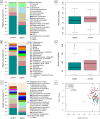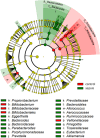Infants < 90 days of age with late-onset sepsis display disturbances of the microbiome-immunity interplay
- PMID: 39541036
- PMCID: PMC12137456
- DOI: 10.1007/s15010-024-02396-6
Infants < 90 days of age with late-onset sepsis display disturbances of the microbiome-immunity interplay
Abstract
Objective: We hypothesized that previously healthy infants < 90 days of age with late-onset sepsis (LOS) have disturbances of the gut microbiome with yet undefined specific immunological patterns.
Methods: We performed a prospective single-center convenience sample study between January 2019 and July 2021 in a case-control design. Routine diagnostics included conventional cultures (blood, cerebrospinal fluid, urine), PCRs and inflammatory markers in infants aged < 90 days with clinical LOS. We additionally analyzed blood lymphocyte subsets including CD4 + CD25 + forkhead box protein (FoxP3)+ Tregs and performed 16 S rRNA sequencing of stool samples, both compared to age-matched healthy controls. Results were adjusted for potential confounders that may influence microbial composition.
Results: 51 infants with fever and clinical LOS were enrolled. Bacterial sepsis was diagnosed in n = 24 (47.1%) and viral infection in n = 13 (25.5%) infants, whereas in 14 (27.3%) infants the cause of fever remained undetermined. When compared to healthy controls, the gut microbiome of LOS infants at disease onset was characterized by a shift in community composition, specifically, decreased abundance of B. longum and an increase of Bacteroidia spp. Intriguingly, the abundance of B. longum negatively correlated with the frequency of blood CD4-positive cells in healthy controls but not in infants with LOS. At one year of age, we observed microbiome differences in infants with history of LOS when compared to healthy controls, such as an increased gut microbial diversity.
Conclusion: Our data suggest potential signatures of the microbiome-immunity interplay in infants with LOS, which should be investigated further as possible targets for prevention.
Keywords: Bifidobacteria; Infants < 90 days; Microbiome; Neonatal immunity; Sepsis.
© 2024. The Author(s).
Conflict of interest statement
Declarations. Competing interests: The authors declare no competing interests.
Figures




Similar articles
-
Infants Younger Than 90 Days Admitted for Late-Onset Sepsis Display a Reduced Abundance of Regulatory T Cells.Front Immunol. 2021 Aug 27;12:666447. doi: 10.3389/fimmu.2021.666447. eCollection 2021. Front Immunol. 2021. PMID: 34512621 Free PMC article.
-
Gut Dysbiosis With Bacilli Dominance and Accumulation of Fermentation Products Precedes Late-onset Sepsis in Preterm Infants.Clin Infect Dis. 2019 Jul 2;69(2):268-277. doi: 10.1093/cid/ciy882. Clin Infect Dis. 2019. PMID: 30329017
-
The Microbiome and Metabolome of Preterm Infant Stool Are Personalized and Not Driven by Health Outcomes, Including Necrotizing Enterocolitis and Late-Onset Sepsis.mSphere. 2018 Jun 6;3(3):e00104-18. doi: 10.1128/mSphere.00104-18. Print 2018 Jun 27. mSphere. 2018. PMID: 29875143 Free PMC article.
-
Lactoferrin impact on gut microbiota in preterm infants with late-onset sepsis or necrotising enterocolitis: the MAGPIE mechanisms of action study.Southampton (UK): NIHR Journals Library; 2021 Sep. Southampton (UK): NIHR Journals Library; 2021 Sep. PMID: 34591437 Free Books & Documents. Review.
-
Development of the gut microbiome in early life.Exp Physiol. 2022 May;107(5):415-421. doi: 10.1113/EP089919. Epub 2022 Jan 30. Exp Physiol. 2022. PMID: 35041771 Free PMC article. Review.
Cited by
-
Persistent reduction of Bifidobacterium longum in the infant gut microbiome in the first year of age following intrapartum penicillin prophylaxis for maternal GBS colonization.Front Immunol. 2025 May 15;16:1540979. doi: 10.3389/fimmu.2025.1540979. eCollection 2025. Front Immunol. 2025. PMID: 40443663 Free PMC article.
-
Metagenomic signatures of extraintestinal bacterial infection in the febrile term infant gut microbiome.Microbiome. 2025 Mar 24;13(1):82. doi: 10.1186/s40168-025-02079-w. Microbiome. 2025. PMID: 40128855 Free PMC article.
References
-
- Ashkenazi-Hoffnung L, Livni G, Amir J, Bilavsky E. Serious bacterial infections in hospitalized febrile infants aged 90 days or younger: the traditional combination of ampicillin and gentamicin is still appropriate. Scand J Infect Dis. 2011;43(6–7):489–94. - PubMed
MeSH terms
Substances
LinkOut - more resources
Full Text Sources
Medical
Research Materials
Miscellaneous

